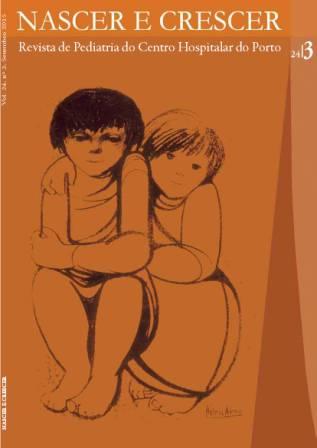Anaphylaxis and food allergy: the result of an intervention in the community
DOI:
https://doi.org/10.25753/BirthGrowthMJ.v24.i3.8511Keywords:
anaphylaxis, epinephrine, food allergyAbstract
Introduction and Objective: Since anaphylaxis is a lifethreatening medical emergency if not treated, community
awareness is important. The objective of this study was to
assess the effectiveness of a workshop about basic concepts
on food allergy and anaphylaxis in schools and nurseries,
aimed to develop in the staff adequate knowledge and timely
management of this clinical conditions.
Methods: Between December of 2013 and March of 2014
we visited six schools attended by children who suffered food
anaphylaxis followed in the Pediatric Clinic of Allergic Diseases.
A questionnaire, approved by the Portuguese Society of
Allergology, was applied before and after the workshop on food allergy and anaphylaxis. A score was calculated according to the number of correct answers. Each correct answer corresponded to one point, maximal score: eight. Descriptive and frequency study and Student t test were used to analyze data, using SPSS Statistics version 20.
Results: Seventy-seven school employers participated in
the sessions, of whom 51 were evaluated before and after the
theoretical session. Regarding the results before the meeting, it was found that 98% of the participants knew that anaphylaxis is a life-threatening emergency and that even very small amounts of the allergen can trigger an anaphylactic reaction. Only 55% recognized the symptoms of anaphylaxis or knew how to properly use an epinephrine autoinjector, and 24% had never heard of epinephrine autoinjector. The average score before and after the sessions was 6.3/8 and 7.5/8 respectively (p<0.001).
Recognition of symptoms and treatment of anaphylaxis were the topics that had a higher increase in the calculated score. All the participants were motivated to receive regular training.
Conclusion: This study demonstrates that half of the staff
caring for children with anaphylaxis could not properly recognize or treat an anaphylactic reaction. The educational workshop was apparently effective in the awareness of this condition. In spite of the study limitations (the size of the sample), our results point out the effectiveness of this kind of intervention to disseminate knowledge on a potentially fatal condition, as well as the need of a regular educational program in the community.
Downloads
References
Tatachar P, Kumar S. Food-induced anaphylaxis and oral allergy syndrome. Pediatrics in review 2008;29:e23-e27.
Waserman S, Watson W. Food allergy. Allergy Asthma Clin Immunol 2011;7:S7
Sicherer SH, Sampson HA. Food allergy: epidemiology, pathogenesis, diagnosis, and treatment. J Allergy Clin Immunol 2014;133:291-307
Sampson HA. Update on food allergy. J Allergy Clin Immunol 2004;113:805-19
Norma nº 014/2012 de 16/12/2012 da Direção-Geral da Saúde
Waibel KH. Anaphylaxis. Pediatrics in review 2008;29:255-63
Koletzko S, Niggemann B, Dias J.A., et al. Diagnostic approach and management of cow’s-milk protein allergy in infants and children: ESPGHAN GI Committee practical guidelines 2012;55:221-29
Simons F, Ardusso L, Dimov V, et al. World Allergy Organization Anaphylaxis guidelines: 2013 update of the
evidence base. Int Arch Allergy Immunol 2013;162:193-204
Sampson HA, Munoz-Furlong A, Campbell RL, et al. Second symposium on the definition and management of anaphylaxis: summary report – Second National Institute of Allergy And Infectious Disease/Food Allergy and Anaphylaxis Network symposium. J Allergy Clin Immunol 2006; 117:391 97
Muraro A, Roberts G, Clark A, et al. EAACI Task Force on Anaphylaxis in Children. The management of anaphylaxis in childhood. Position paper of the European Academy of Allergology and Clinical Immunology. Allergy. 2007;62:857-71
Cheng A. Emergency treatment of anaphylaxis in infants and children. Paediatr Child Health. 2001;16:35-40
Lieberman P, Decker W, Camargo JA Jr, Oconnor R, Oppenheimer J, Simons FE. SAFE: a multidisciplinary approach to anaphylaxis education in the emergency department. Ann Allergy Asthma Immunol. 2007; 98:519-23
Sicherer SH, Sampson HA. Food Allergy. J Allergy Clin Immunol 2010; 125: S116-25
Langley EW, Gigante J. Anaphylaxis, urticaria, and angioedema. Pediatrics in review 2013;34:247-57
Turner PJ. Persistent allergy to cow’s milk: of greater a clinical concern than other food allergies. Pediatric Allergy and Immunology 2013; 24:624-26
Downloads
Published
How to Cite
Issue
Section
License
Copyright and Authors' Rights
All articles published in Nascer e Crescer - Birth and Growth Medical Journal are Open Access and comply with the requirements of funding agencies or academic institutions. For use by third parties, Nascer e Crescer - Birth and Growth Medical Journal adheres to the terms of the Creative Commons License "Attribution - Non-Commercial Use (CC-BY-NC)".
It is the author's responsibility to obtain permission to reproduce figures, tables, etc. from other publications.
Authors must submit a Conflict of Interest statement and an Authorship Form with the submission of the article. An e-mail will be sent to the corresponding author confirming receipt of the manuscript.
Authors are permitted to make their articles available in repositories at their home institutions, provided that they always indicate where the articles were published and adhere to the terms of the Creative Commons license.


